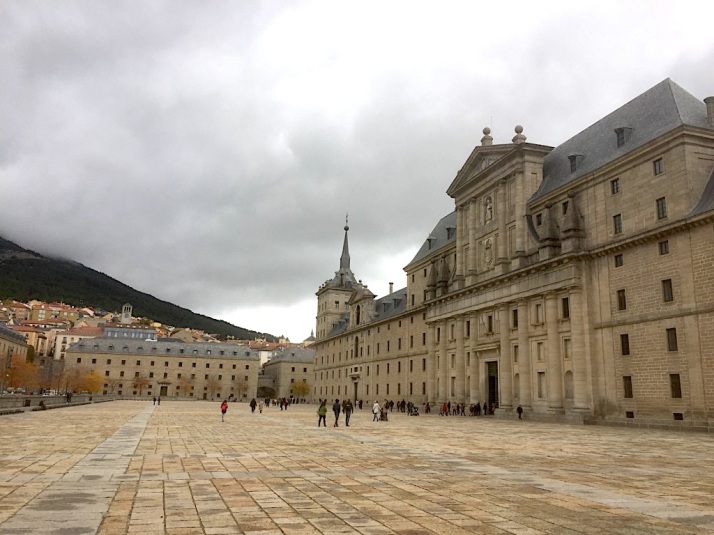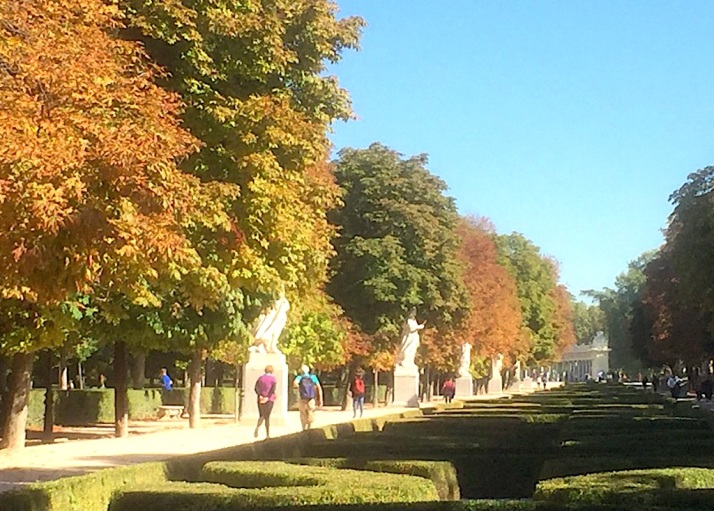For the past five centuries, the Habsburg and then the Bourbon royal families have ruled Spain. In this time, they helped to develop Madrid into one of the world’s great capital cities. Now, they all lie together in a burial chamber befitting a king.

Equestrian Portrait of Charles V, by Titian (Prado Museum)
In the year 1500, the future Holy Roman Emperor Charles V was born in the Flemish region of present-day Belgium. When he assumed the Spanish crown as a teenager, he became the first of the Spanish Habsburg monarchs.

Alcázar of Toledo
To visit Charles V’s power center in Spain, we took the train 30 minutes south of Madrid to the historical hilltop town of Toledo. Towering above the remnants of Roman, Visogothic, and Moorish history is the imposing former Alcázar palace of Charles V.

Royal Site of San Lorenzo de El Escorial
After Charles V’s 40-year reign, his son Philip II became the first Spanish-born Habsburg monarch. With his seemingly endless supply of New World gold, Philip II constructed a great monastery, palace, and royal mausoleum in the town of El Escorial, located 28 miles (45 km) northwest of Madrid.

Buen Retiro Park
Philip II also established Madrid as the capital of the Spanish Empire. He developed grand buildings and elegant plazas, and expanded his royal retreat Buen Retiro Park, now a peaceful public paradise.

Las Meninas, by Diego Velázquez (Prado Museum)
Within Buen Retiro Park is the Prado Museum. Originating from the Spanish Royal Collections, the Prado is one of the world’s greatest repositories of European art. It’s most famous painting is “Las Meninas”, by Diego Velázquez, in which the artist portrays a complex and enigmatic scene from the Habsburg court of Philip IV.

Royal Portrait of Charles II
Philip IV was married to his niece, and their son and heir Charles II became an unfortunate victim of this Habsburg inbreeding. With a deformed oversized jaw, Charles II was not able to speak clearly or chew his food. Unable to walk until the age of eight, he grew up physically and intellectually stunted, impotent, and infertile.

Bourbon King Charles IV and His Family, by Francisco Goya (Prado Museum)
When poor Charles II failed to produce an heir, the reign of the Habsburgs in Spain came to an end. After the Spanish War of Succession, the monarchy of Spain was taken up by Philip V, grandson of the French Bourbon King Louis XIV.

Royal Palace and Almudena Cathedral (background)
When their royal residence burned down in 1734, the Bourbons rebuilt a lavish palace of enormous proportions. The Royal Palace of Madrid includes a floor area of 1.45 million square feet (135,000 square meters), making it the largest in Europe.

Bourbon King Philip VI motorcade arriving at Royal Palace
No longer the royal residence, the Royal Palace of Madrid is now only used for ceremonial purposes. One day, we watched as the motorcade of the current Bourbon King Felipe VI arrived at the Royal Palace for lunch meetings. On another day, we witnessed the pageantry and tradition of the monthly changing of the palace guard.

Pantheon of Kings, El Escorial (photo: Lápides Moreno)
Dating back five centuries to the Holy Roman Emperor Charles V, Spain has been ruled almost continuously by just two dynastic families. The monarchs now lie together in the Pantheon of Kings beneath the El Escorial monastery palace, a communal tomb befitting the Habsburgs and the Bourbons.

Cheers to Charles Quint!
Feature Image: Monthly changing of the guard at the Royal Palace of Madrid

Charles V looks like quite the dashing fellow. Charles II, not so much. Poor guy.
That painting, Las Meninas, I think I could stare at it for hours and still not pick up everything. Is Velázquez in it, looking at us, and painting what we’re seeing?!
LikeLiked by 1 person
Good eye picking out Velázquez, Christi. I read that the subject of his painting in the picture is King Philip IV and his niece-wife, whose reflection can be seen in the mirror on the back wall. The 5 year old girl in the center of the picture is their eldest daughter Margaret Theresa who did not appear to have inherited the Habsburg jaw or other genetic defects associated with inbreeding. Her poor younger brother Charles II was not so lucky.
LikeLiked by 1 person
Now I’ve added Madrid to my list of places I hope to visit someday. What a treasure trove of art and history! The painting of the family is fascinating, and so is the history of the royal families. I think inbreeding was a common problem with most royalty, since they could choose a spouse from such a small group of people, most of whom were relatives. Thanks for another great post, Joe! I love following your blog.
LikeLiked by 1 person
Thank you so much, Ann. I love your writing, and corresponding with you too. Spain is a beautiful and interesting country, and Madrid is a good representation of its urban character. I have been happy to learn something about its monarchy. It is an important aspect of Spanish history, and is full of colorful characters.
LikeLiked by 1 person
The Prado’s one of the great ones, isn’t it? I had forgotten about El Escorial. The name sounded familiar so I looked in a pack of pics from our Spain trip way back when, and sure enough, there it was. I remember one bit of trivia from that visit; learning that the Philippines were named after King Philip II of Spain. Somehow I hadn’t made that connection. And since a lot of my in-laws live in the Philippines, it holds a little more interest.
LikeLiked by 1 person
With over one thousand paintings, the Prado is a lot of art to try to tackle in a day. Before going in, I did some research and made a list of about 80 pictures that I wanted to be sure to see. It still took me four hours to appreciate them all. Like us, you probably combined your trip to El Escorial to the nearby Valley of the Fallen. That was another full and interesting day.
LikeLike
I noticed you used someone else’s photo of the Pantheon of Kings, Joe. Is that because you’re not allowed to snap photos there? It looks magnificent! A very interesting history; I’ve heard of the families by reference only, so this was my first time really learning about them. Of course, now I’d love a beer for some reason too… – Marty
LikeLiked by 1 person
Hi Marty, Like in many of the museums and historic sites in Spain, they enforce an uncompromising “No Photo” policy. Thankfully, with the help of Google Images, I was still able to show this truly remarkable place. Standing inside the one-room Pantheon of Kings, surrounded by the tombs of 26 Spanish monarchs, left a big impression on me. The beer and tapas of Spain have also left a big impression, but that is another story. Cheers! – Joe
LikeLiked by 1 person
This post is very Awesome and mind-blowing. thanks for sharing this attractive pictures and this post. Thank you so much for sharing fantastic photos and wonderful experience with us keep posting.
LikeLiked by 1 person
Thank you for your comment. I am happy that you enjoyed the post.
LikeLike
I don’t know much at all about the Spanish Royal family so have found this post very interesting. I would love to visit the Prado, is it as big as the Louvre in Paris?
LikeLiked by 1 person
Hi Gilda, The royal palaces, city monuments, and museums here in Madrid make it easy to piece together the history of the Spanish monarchy. The royal art collection at the Prado is full of famous portraits and landscapes. It is big, but pales in comparison to the Louvre, which is the world’s largest art museum. Its famous Paris rival has five times more floor space and thirty times more works of art.
LikeLiked by 1 person
Excellent post Joe. How I wish history lessons were taught like this in schools. With some excellent photographs and precise , to the point descriptions.
LikeLiked by 1 person
Thank you very much, Deepa. I really appreciate your comments. I never liked history in school. Now that I have started traveling, history has come to life. For me, learning the chronology of events and some background information provides a framework for understanding a location and its place in the world. Visiting the location is fun and helps me to visualize what I have learned.
LikeLike